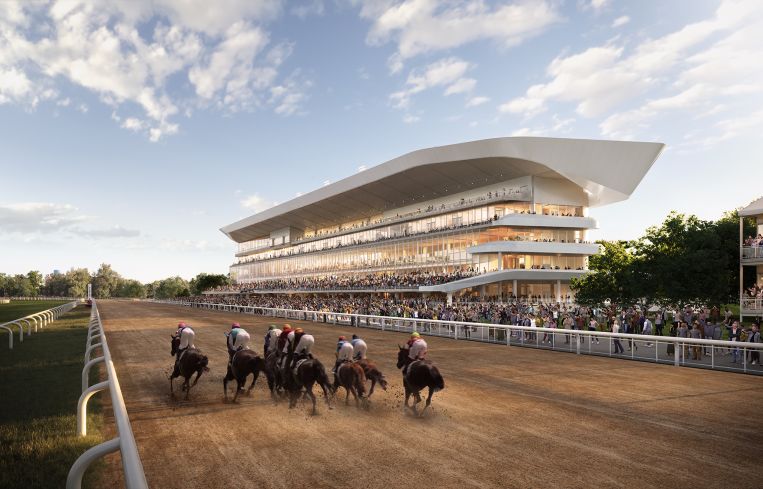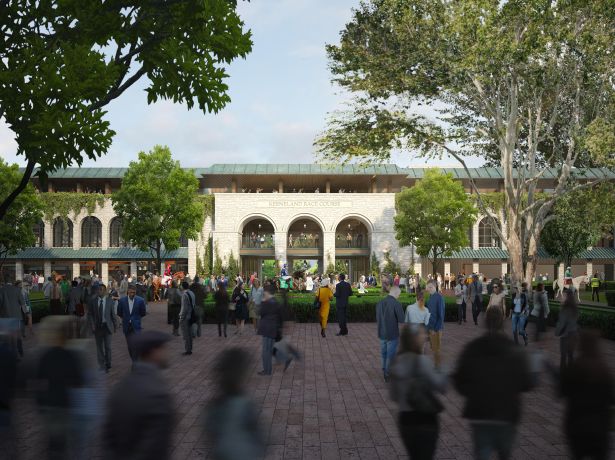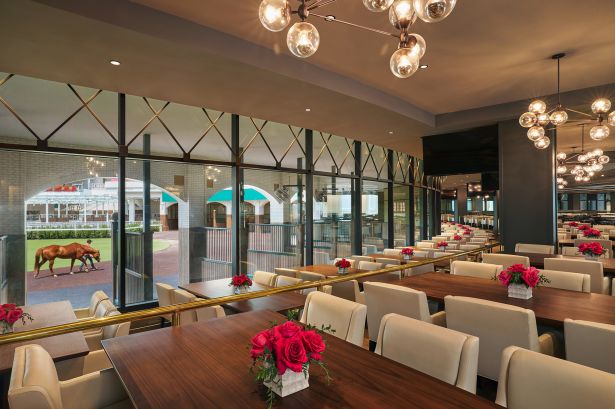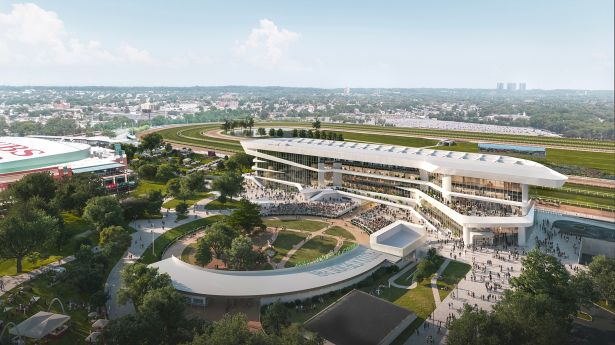Famed Horse Racing Spots — Including the Triple Crown Venues — Get Makeovers
It’s all about chasing the experiential trend amid an influx of new fans at Churchill Downs, Belmont Park and Pimlico
By Anna Staropoli May 1, 2025 6:00 am
reprints
When you visit Keeneland in Lexington, Ky., you pass over hallowed ground that’s played host to famous movie stars, equally famous thoroughbreds and even Queen Elizabeth II. As early as this fall, however, Keeneland’s new paddock building will merge the track’s near century of history with modern amenities, indicating a larger development trend for horse racing infrastructure.
Alongside Keeneland, New York’s Belmont Park and Saratoga Race Course, Kentucky’s Churchill Downs (site of the Kentucky Derby) and Maryland’s Pimlico Race Course (home of the Preakness) are undertaking various renovation, construction and expansion projects. Whether reviving a paddock, a clubhouse building or the track grounds, each venue has renewed its focus on spectator experiences.
“The thoroughbred industry is evolving, and major tracks are investing in renovations to meet demand and enhance the race-day experience,” Christa Marrillia, Keeneland’s vice president and chief marketing officer, told Commercial Observer via email. “These projects reflect a shared commitment to elevating the sport and ensuring that venues remain world-class destinations for racing.”
To remain world-class destinations, however, the United States’ best-known tracks are prioritizing experiences beyond the minutes-long horse races. As demand skyrockets for in-person events, many tracks are revamping their facilities into multi-use, well-rounded venues, with particular attention to how patrons move through the space and spend the bulk of their time. Many, therefore, are sharpening their amenities to create hospitality-driven tracks better aligned with a present-day racing audience that might be new to the sport.
“There’s major growth in this industry coming, and it’s already happening, but I think we’ll see more of it,” said Mason Paoli, senior principal and interior design director for architecture design firm Populous, which has worked on most major track development projects. “We’re all glued to our phones, we’re oversensitized. … Culturally, I think we’re craving some of those more primitive, back-to-basics experiences.”
This emphasis on experiences seemingly rides the coattails of the pandemic and the resulting impetus for in-person, communal activities. Yet, many racetrack renovation projects were in the works prior to 2020 to draw new fans to horse racing and meet future demand.
For example, Keeneland’s series of $93 million development projects grew, in part, as demand for tickets exceeded supply. The track’s projects address this by creating more opportunities for people to experience Keeneland on race days, said Marrillia.

In Queens, Belmont Park’s attendance numbers peaked in 2014, then again in 2018 when a horse named Justify won the final race of the Triple Crown. (To win the Triple Crown, a single horse must win all three major annual races: the Kentucky Derby, the Preakness and the Belmont Stakes. If the same horse wins the first two races, attendance at Belmont usually spikes.)
“Experiential kind of starts to take over — and that trend was really apparent before the pandemic,” said David O’Rourke, president of the New York Racing Association. (NYRA also counts SL Green Chairman and CEO Marc Holliday, a longtime equestrian, as chairman of its board since 2021.) “That plays into these boutique meets and the higher end of racing or the Triple Crown, where it’s really an event. You get dressed up, you go out — it really appeals to a wide subset of demographics.”
Belmont’s development projects have been thought about for the last two decades, O’Rourke added, though New York State approved the project’s $455 million loan only in 2024. Now, the 117-year-old Triple Crown track is broadening to become a more flexible space, with year-round, multipurpose opportunities, new tunnels and a winterized, synthetic track surface. (Belmont is spending roughly $100 million outside of NYRA’s loan to redo those racing surfaces.) The old grandstand overlooking that track was demolished in 2024, and will be replaced with a new structure entirely. Because work is still underway, the Belmont Stakes this year will be held June 7 at Saratoga.
Similarly, Churchill Downs in Kentucky has undertaken various construction projects over the last decade. Roughly 11 years ago, Populous helped implement a more utilitarian space for the Winner’s Circle. Since then, the track has completed additional renovations and, in February, announced a $920 million series of projects slated for completion by 2028. (As of mid-April, however, Churchill Downs announced plans to pause select development projects, citing economic uncertainties amid tariff- and trade law-induced costs. The projects that will continue account for a smaller, $25 to $30 million budget, focused on improving the Trophy Room and Finish Line suites by next April.)
Granted, the sport still faces problems in generating interest. Outside of those Triple Crown races, many tracks have endured empty stands and dwindling ticket sales. Horse racing at large, however, appears poised for a resurgence, with global growth anticipated to reach roughly $182.4 billion by 2030 from around $127 billion today, according to a horse racing market forecast. That report pinpointed both demand for social events and the rise of online betting as contributing factors to racing’s growing popularity.
This renewed engagement doesn’t pertain to just horse racing. Sports arenas, entertainment venues and other multi-use spaces have seen an uptick in interest over the last few years. “From stadiums to arenas, the modern sports experience is no longer just about the game. It’s about creating an atmosphere that blends tradition with elevated amenities,” said Marrillia.
Horse racing, however, allows for a specific type of engagement, and therefore requires a specific type of design. A typical sports arena attracts a crowd for a single three-hour event, often broken up by a halftime intermission. But a horse track runs a series of brief races throughout the day, with long stretches of downtime in between. That lends itself to a distinctive, dynamic experience, said Paoli.
“There’s a very complex user journey path through each of these projects,” she said, pointing to elements such as the actual racetrack, the grandstand and the paddock, as well as all the operational infrastructure focused on dining, betting and behind-the-scenes components.
“We’re always looking for: How do we create memories with the spaces that we do?” said Paoli. “We do that by celebrating the history, by adding technology to modernize the experience.”
To enhance that experience, for instance, Populous installed glass in Churchill Downs’ Paddock Club and relocated the saddling stalls. That way, diners can enjoy their meals as they observe jockeys in the tunnel.

Meanwhile, Belmont is overhauling that old grandstand and clubhouse building to make room for improved facilities. The new grandstand within a roughly 275,000-square-foot building will be narrower, yet slightly taller, than the old one. Its glass walls likewise will enable 360-degree views — yet another experience — from within the building.
Due to this change in the building’s scale, Belmont can now expand from 5 acres of green space to roughly 30. “We’ve kind of brought the park back into Belmont Park,” said O’Rourke, who outlined the park’s plans to host activities beyond horse racing and serve as a community space.
The track’s sharpened focus on experiences is also aimed at downplaying a long-held association with horse racing: betting. “You’re really taking something that used to be all about gambling — going to the track to gamble — and now you’re turning it into a place where nature meets sport, meets art,” said O’Rourke. “You want to push forward into the future, but you want to respect the past.”
Designing or redesigning racetracks to appeal to new audiences often means balancing betting with other amenities, said Paoli. “We provide the infrastructure for the sports betting because that’s a fun part of the experience, but I would say hospitality is at the top of priorities,” Paoli said.
After all, horse racing has been around for centuries, and in its heyday around 1890 some 314 tracks spanned the country — each with its own personality, said Paoli. Accounting for that much history, while implementing modern, technology-driven amenities, requires a careful design approach specific to each track’s individual story.
Tapping into a design team’s expertise is therefore important, given the number of moving parts in a track development project. At any given venue, the real estate needs to accommodate owners, trainers, horses, jockeys and patrons, as well as food and beverage, staff, the sales team and more. To pull off this feat, Populous also works with an Oklahoma-based equine design specialist that helps during the site plan process.
“These horses literally walk through a tunnel through the middle of the building,” said O’Rourke. “You’ve got to get the right operating people in the room with the designers at a very early stage. Otherwise you could really put yourself in a corner in terms of what is realistic and safe.”

While O’Rourke accredits Populous as an established expert in track design, the architecture firm attributes its successes to client guidance. Each track — whether Keeneland, Belmont or Churchill Downs — understands its respective audience and goals for patron experiences. They all, then, adhere to similar development fundamentals, but maintain a distinctive style, personality and nod to tradition.
Keeneland, for example, has always prioritized community engagement, as the grounds remain open to the public daily, and visitors can take guided tours or visit the archival library. The new development projects embrace this community-first mentality, but with a more curated approach to hospitality. The rooftop project, for instance, balances indoor with outdoor seating, and will be a place to grab a cocktail in addition to catching a handsome view.
Yet, while this project accounts for leisure time between races, Keeneland’s approach to design has always been intentional across the track. In the 1980s, the Winner’s Circle was built so Queen Elizabeth II didn’t have to cross the tracks, while throughout the grounds spectators won’t see billboards, logos or sponsorship signage. Instead, the decorations maintain the same green and white pattern, purposefully designed to appeal to movie directors. Without logos, Keeneland’s track can more easily become a film location.
With the current renovations, “preserving Keeneland’s history and character is paramount,” said Keeneland’s Marrillia. The new structures will maintain the track’s integrity and incorporate consistent features such as Keeneland’s trademark two-over-two stonework pattern. “Every decision — whether in design, materials or layout — balances modern enhancements with the timeless aesthetic that makes Keeneland so special,” she said.
Many of these development projects overlap with Keeneland’s race meets, training sessions and sales events such as horse auctions. Rather than relocate its events, however, the track has remained open during this construction period, taking advantage of its opportunities. (Churchill Downs has likewise remained open during renovations.)
“While this required considerable effort and flexibility, one positive outcome was the opportunity to reroute our fans through the barn area to access our North Gate, as our East Gate is currently under construction,” said Marrillia. “Along the route, we incorporated educational moments, unique photo opportunities and giveaways — turning a potential inconvenience into an engaging, behind-the-scenes experience.”
Multitasking, then, is the name of the game in horse track design, which can leverage infrastructure to potentially introduce new audiences to a centuries-old sport.
“These projects, a lot of times, haven’t been touched in decades,” said Paoli. “The fact that they’re still running and people still enjoy it is a testament to, I think, the viability of the sport. … Even if the architecture isn’t matching the experience, I think people are still paying for it.”


